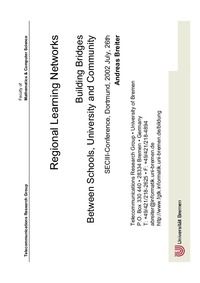Regional learning networksBuilding bridges between schools, university and community
Zu finden in:
|
 |
 Zusammenfassungen
Zusammenfassungen
 The so-called "digital divide" seems to be a major social obstacle for the Information Society. Most experts agree that citizens will need competencies that go beyond the basic cultural skills. But where to get them? The idea of life-long-learning illustrates a major problem of our educational institutions: they work separately, they only process the results of the preceding phase and there is a lack of interconnection. This paper tries to develop a concept of a regional education network that includes pre-school, K-12 and further education, public libraries and community centers as well as other educational institutions. Following the path of the digital divide as a social and educational divide and focusing on the school as one major player in the regional network, the innovation process and the actors will be highlighted. Using action research in a project between schools, local community, private partners and the university, the idea of the regional network is illustrated, the encountered problems are described in order to give an impression of the realistic view of an integrated education policy.
The so-called "digital divide" seems to be a major social obstacle for the Information Society. Most experts agree that citizens will need competencies that go beyond the basic cultural skills. But where to get them? The idea of life-long-learning illustrates a major problem of our educational institutions: they work separately, they only process the results of the preceding phase and there is a lack of interconnection. This paper tries to develop a concept of a regional education network that includes pre-school, K-12 and further education, public libraries and community centers as well as other educational institutions. Following the path of the digital divide as a social and educational divide and focusing on the school as one major player in the regional network, the innovation process and the actors will be highlighted. Using action research in a project between schools, local community, private partners and the university, the idea of the regional network is illustrated, the encountered problems are described in order to give an impression of the realistic view of an integrated education policy. The so-called “digital divide” seems to be a major social obstacle for the Information Society. Most experts agree that citizens will need competencies that go beyond the basic cultural skills. Where can our citizens acquire these competencies? The idea of life-long-learning illustrates a major problem of our educational institutions: they work separately, they only process the results of the preceding phase and there is a lack of interconnection. This paper tries to develop a concept of a regional education network that includes pre-school, K-12 and further education, public libraries and community centres as well as other educational institutions. Taking the path of the digital divide as a social and educational divide and focusing on the school as one major player in the regional network, the innovation process and the actors involved in it are highlighted and explored. Using action research in a project between schools, local community, private partners and the university, the concept of the regional network is illustrated. The problems encountered in the project are described and discussed in order to give a realistic overview and impression of an integrated education policy.
The so-called “digital divide” seems to be a major social obstacle for the Information Society. Most experts agree that citizens will need competencies that go beyond the basic cultural skills. Where can our citizens acquire these competencies? The idea of life-long-learning illustrates a major problem of our educational institutions: they work separately, they only process the results of the preceding phase and there is a lack of interconnection. This paper tries to develop a concept of a regional education network that includes pre-school, K-12 and further education, public libraries and community centres as well as other educational institutions. Taking the path of the digital divide as a social and educational divide and focusing on the school as one major player in the regional network, the innovation process and the actors involved in it are highlighted and explored. Using action research in a project between schools, local community, private partners and the university, the concept of the regional network is illustrated. The problems encountered in the project are described and discussed in order to give a realistic overview and impression of an integrated education policy. Dieser wissenschaftliche Zeitschriftenartikel erwähnt ...
Dieser wissenschaftliche Zeitschriftenartikel erwähnt ...
 Dieser wissenschaftliche Zeitschriftenartikel erwähnt vermutlich nicht ...
Dieser wissenschaftliche Zeitschriftenartikel erwähnt vermutlich nicht ... 
 Nicht erwähnte Begriffe | Bildung, Digitalisierung, Kinder, LehrerIn, Nolan-Stage I: Initiation, Nolan-Stage II: Contagion, Nolan-Stage III: Control, Nolan-Stage IV: Integration, Unterricht |
 Tagcloud
Tagcloud
 Zitationsgraph
Zitationsgraph
 Zitationsgraph (Beta-Test mit vis.js)
Zitationsgraph (Beta-Test mit vis.js)
 Anderswo finden
Anderswo finden
 Volltext dieses Dokuments
Volltext dieses Dokuments
 Anderswo suchen
Anderswo suchen 
 Beat und dieser wissenschaftliche Zeitschriftenartikel
Beat und dieser wissenschaftliche Zeitschriftenartikel
Beat hat Dieser wissenschaftliche Zeitschriftenartikel während seiner Assistenzzeit an der ETH Zürich ins Biblionetz aufgenommen. Die bisher letzte Bearbeitung erfolgte während seiner Zeit am Institut für Medien und Schule. Beat besitzt kein physisches, aber ein digitales Exemplar. Eine digitale Version ist auf dem Internet verfügbar (s.o.). Es gibt bisher nur wenige Objekte im Biblionetz, die dieses Werk zitieren.












 Hochschule
Hochschule Informationsgesellschaft
Informationsgesellschaft Innovation
Innovation Internet
Internet Lernen
Lernen Phasenmodell von Nolan
Phasenmodell von Nolan Schule
Schule Support
Support Universität
Universität



 , 809 kByte)
, 809 kByte)  Biblionetz-History
Biblionetz-History